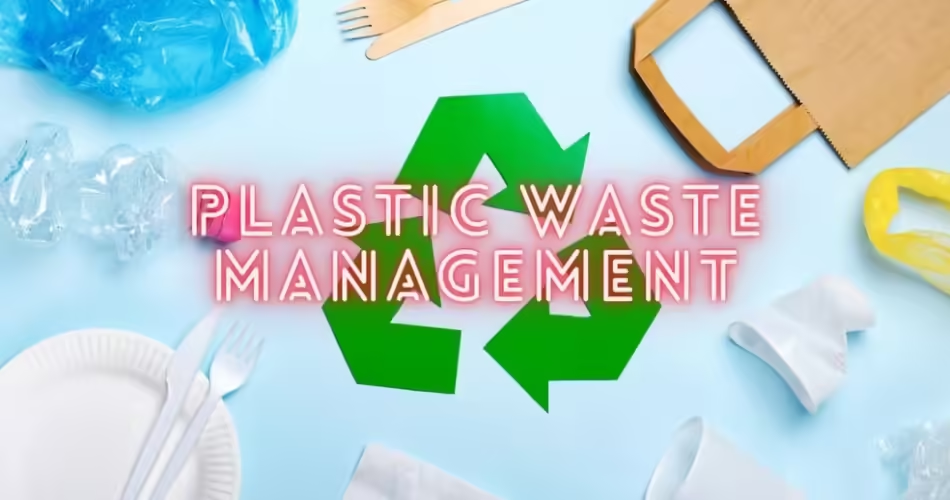This blog will guide you about Plastic Waste Management. Firstly you will get to know about what plastic is and what is Plastic Waste. Secondly you will discover why plastic is so dangerous for Hydrosphere, Lithosphere and Atmosphere. At the end you will get to know some of the efficient and useful Plastic Waste Management Strategies that can be applied on global level or country level.
What is Plastic?
Plastic is a synthetic material made from a wide range of organic polymers such as polyethylene, PVC (Polymer of Vinyl Chloride), Nylon etc. It is invented to replace costly materials such as glass, fabric, and other materials used in packaging and transfer of goods from one place to another. Plastic is widely used in every sector and is mainly used for transportation of goods and packaging purposes.
What is Plastic Waste?
Any discarded material or good made of plastic is termed as plastic waste. As we know that plastic is used in bulk in all the sectors, so there is a huge amount of plastic waste that produces everyday in the world and unfortunately it is now uncontrollable.
We cannot completely eliminate it. As it is now a great threat to every system of the earth i.e. Lithosphere, Hydrosphere and Atmosphere.
Examples of Plastic Waste:
Plastic Water Bottles
Shopping bags
Shampoo bottles
Balloons
Disposable eating mats, cups, plates etc.
Fishing Nets
Plastic Wrappers
Decoration pieces
Artificial Flowers
Phone Covers
etc.
All of these and many more types of plastic wastes are produced on the Earth and they are left to harm the planet so these have became a great threat to our environment. We will discuss some Plastic Waste Management Strategies in this blog.

Why is Plastic Pollution Dangerous for Environment?
This Pollution is now became a new term of pollution because of its huge network throughout the world. Plastic pollution means the part of pollution that occurs as the result of plastic waste. Plastic pollution is dangerous of every part of earth’s environment. If plastic pollution continues to increase, this will get double to 370 metric tons by 2025. There is explanation about each part of the environment in the context of their effects on plastic waste.
• Effects on Hydrosphere:
Plastic pollution is disposed into the lakes and canals and it ends up in the ocean so Aquatic environment faces the significant issue raised by plastic pollution. As we know that people don’t know how to dispose off the plastic pollutants properly and leave them on the beaches. The ocean water takes them into the ocean. These wastes kills millions of aquatic animals by choking, by trap, and by many other means. I.e. bottle caps block the respiratory system of the fishes and cause them to die. The aquatic animals who eat plastic unknowingly, it can cause toxic materials and pollutants to enter into their stomach and harm them.
Other than physical effects on aquatic species, plastic pollution also cause negative changes in composition of the ocean. As plastic takes the pollutants with it to a longer distance and is a great cause of transfer of pollutants from one region to another.
• Effects on Lithosphere:
Plastic pollution comprises most of the present day land pollution. Plastic bags and bottles are everywhere on the ground even at the most beautiful and aesthetic places in the world. This is hardly damaging the beauty of Earth and also adding harmful pollutants to our environment. Plastic wastes do not decompose for thousands of years. The only way to stop and control this is to pick it up from polluted places or eliminate their use to avoid plastic pollution.
Animals who eat food openly such as grass, leaves etc. can eat plastic unknowingly and this can cause choke, stomach disorders and many more harmful effects on animal life. The water that animals drink from rivers and canals are with toxic pollutants containing a lot of plastic waste. Microplastics absorbs solar radiations and traps them on the surface thus causing Global warming.
• Effects on Atmosphere:
Plastic pollution also contributes in the atmospheric pollution at a great extent. It is a prediction that plastic pollutions when rotten and old, emits additional 184 to 213 metric tons of Green House Gases every year. The landfills that contain single-used plastic emits about 15% of the methane emissions. More plastic pollution will increase the size of landfills and it will increase the methane emissions so in this way it cause drastic effects on the composition of atmosphere and play a great role in Climate change.
Plastic Waste Management:
We use plastic in every sector in this industrial and economic era. And it is impossible to eliminate it abruptly because of increase of plastic pollution. So, we should gradually shift on alternatives of plastics in our daily life. Then we will be able to fight with plastic pollution and conquer this battle.
We can reduce plastic pollution by applying Plastic Waste Management Practices described as follows:
1.Shift to Biodegradable Plastics:
We can shift on to Biodegradable and edible plastic from the conventional harmful plastics. A man named as Michael Vanduzee, made biodegradable plastic at home in the kitchen. He used sugar, glycerin, vinegar and water to prepare his own eco-friendly plastic and then it its dried for few days. It is same as the normal plastic but is sustainable, biodegradable and even edible. We should try to make more plastic from this technique and use in the place of conventional plastic.
2.Recycling Plastic:
Many people are working on the recycle of plastic wastes by recycling the bottles, reusing the plastic cups and other things for different purposes. New York city uses 23 Billion plastic bags every year. Alex Dabagh started to collect these plastic bags from the city and other places in New York so he and his family transforms single used plastic bags into new and reusable bags for public. This is a great innovation that prevents most of the plastic bags from adding into the oceans and causing harm to humans and aquatic life.
3.Efficient Disposal of Plastic Wastes:
Most of the problems arise by plastic pollution by its inefficient disposal of plastic wastes so Plastic wastes should be forbidden to be thrown on the roads, beaches, public places, schools and other places. There should be separate dustbins for plastic wastes so that it can be disposed off very carefully away from any kind of life (in water or on land). This will reduce the health risks from plastic pollutions at a great extent and you will be able to see improvement around you. We should also spread awareness about importance of proper disposal of Plastic wastes. It will make the waste management disciplined.
4.Avoid using Disposable Plastic Cutlery:
We should reduce or avoid the use of disposable plastic cutlery for eating and drinking food. The main reason is that plastic eating mats and cutlery are one time use and then they adds into the trash. We should use glass, steel and metal cutlery that we can reuse for years and are washable after every use. Disposable plastic cutlery are also harmful for health if we eat food at high temperature. That is why using disposable plastic cutlery are harmful for human health and environment in every way. Instead of using plastic stuff, we should shift on biodegradable disposable cutlery. This will automatically reduce plastic pollution.
5.Create Barriers in Oceans to Stop Plastic Wastes:
Oceans are the final place for all the plastic wastes disposed off onto the beaches so this cause massive water pollution in ocean by spreading water pollutants and it is a significant cause of Ocean Acidification. Because aged plastic may increase acidity and decrease the pH of water. This enhance the ocean acidification phenomena. We should try our best to keep plastic waste away from the beaches and oceans. We can establish barriers by bubbles, walls or floating materials to prevent plastic waste from entering into the ocean and harm the composition of natural ocean environment so this kills aquatic organisms and adds tons of microplastics into the ocean every year.
6.4R Strategy:
4R strategy means Reduce, Reuse, Recycle and Recover. In the context of plastic wastes, Reduce refers to the reduction of plastic goods and equipment to reduce plastic pollution so Reuse means to try not to dispose off plastic products after single use, and try to use it for a long time to prevent it to become a waste and add into the pollution. Recycle means to recycle old plastic for different purposes to keep them in use and avoid disposing in this way. Recover means to transform old plastic goods to new and usable good to increase their life span. All of these will help us to reduce plastic waste from the earth and this will be a fight against plastic pollution.
These were some of the Plastic Waste Management Strategies.

Conclusion:
Plastic waste is any discarded material made of plastic. Human Population creates plastic waste in huge amount every year on global levels comprising of plastic pollution. It is a global issue because plastic waste is increasing every year and causing many environmental problems. It is harmful for all systems of Earth i.e. lithosphere, hydrosphere and atmosphere. We can manage plastic pollution by switching onto biodegradable plastic, efficient plastic disposal, recycling of plastic, creating barriers for plastic wastes in oceans and 4R strategy. All this will help us to defeat the problem of Plastic Pollution and environmental damage caused by plastic pollution. We discuss few Plastic Waste Management Strategies in this blog.
To learn about more topics, Click the links below:


Comments